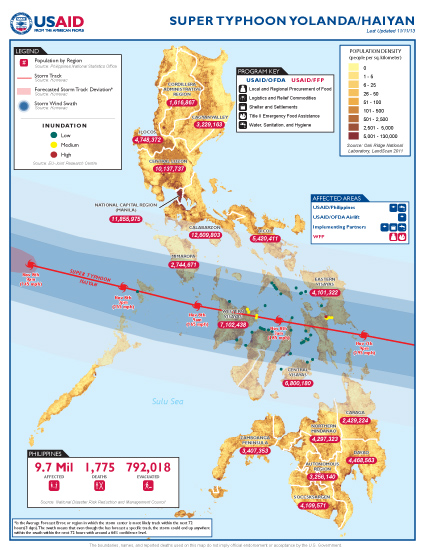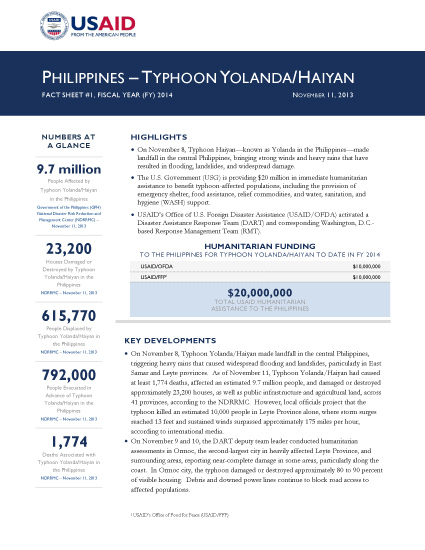- What We Do
- Agriculture and Food Security
- Democracy, Human Rights and Governance
- Economic Growth and Trade
- Education
- Ending Extreme Poverty
- Environment and Global Climate Change
- Gender Equality and Women's Empowerment
- Global Health
- Water and Sanitation
- Working in Crises and Conflict
- Disaster Assistance
- Political Transition Initiatives
- Conflict Mitigation and Prevention
- Countering Violent Extremism
- Disaster Risk Reduction
- Peacebuilding and Reconciliation
- Providing Safe & Secure Environments for Development
- Recovering From Crisis
- Resilience
- Tech Challenge for Atrocity Prevention
- World Humanitarian Day
- U.S. Global Development Lab
November 11, 2013
Super Typhoon Haiyan Map - 11/11/2013 ![]() (pdf - 550k)
(pdf - 550k)
Numbers At A Glance
9.7 million
23,200
615,770
792,000
1,774
Humanitarian Funding:
To The Philippines For Typhoon Haiyan/Yolanda To Date In FY2014:
| USAID/OFDA | $10,000,000 |
| USAID/FFP | $10,000,000 |
| TOTAL | $20,000,000 |
Typhoon Haiyan / Yolanda Fact Sheet #1 - 11/11/2013 ![]() (pdf - 201k)
(pdf - 201k)
Highlights
On November 8, Typhoon Haiyan—known as Yolanda in the Philippines—made landfall in the central Philippines, bringing strong winds and heavy rains that have resulted in flooding, landslides, and widespread damage.
The U.S. Government (USG) is providing $20 million in immediate humanitarian assistance to benefit typhoon-affected populations, including the provision of emergency shelter, food assistance, relief commodities, and water, sanitation, and hygiene (WASH) support.
USAID’s Office of U.S. Foreign Disaster Assistance (USAID/OFDA) activated a Disaster Assistance Response Team (DART) and corresponding Washington, D.C.- based Response Management Team (RMT).
Key Developments
On November 8, Typhoon Yolanda/Haiyan made landfall in the central Philippines, triggering heavy rains that caused widespread flooding and landslides, particularly in East Samar and Leyte provinces. As of November 11, Typhoon Yolanda/Haiyan had caused at least 1,774 deaths, affected an estimated 9.7 million people, and damaged or destroyed approximately 23,200 houses, as well as public infrastructure and agricultural land, across 41 provinces, according to the NDRRMC. However, local officials project that the typhoon killed an estimated 10,000 people in Leyte Province alone, where storm surges reached 13 feet and sustained winds surpassed approximately 175 miles per hour, according to international media.
On November 9 and 10, the DART deputy team leader conducted humanitarian assessments in Ormoc, the second-largest city in heavily affected Leyte Province, and surrounding areas, reporting near-complete damage in some areas, particularly along the coast. In Ormoc city, the typhoon damaged or destroyed approximately 80 to 90 percent of visible housing. Debris and downed power lines continue to block road access to affected populations.
CURRENT SITUATION
- Typhoon Yolanda/Haiyan had resulted in at least 1,774 deaths, with some media reports citing projections of more than 10,000 fatalities in Leyte Province, and injured 71 people as of November 11, according to the NDRRMC. The GPH and humanitarian partners expect the death toll and damage reports to increase in the coming days as transportation and communications systems are restored and as more information becomes available.
- National authorities indicate that the typhoon likely caused the most significant damage in the Philippines’ Eastern Samar and Leyte provinces, with additional damage reported in Bohol, Cebu, and Samar provinces. However, the U.N. notes that the scale of destruction in affected areas is unknown, as many areas remain inaccessible. Manila, the Philippines’ capital city, experienced minimal rainfall and wind damage from the typhoon.
- The GPH has led the disaster response in the Philippines, establishing two forward command posts, including one in most-affected Tacloban city, Leyte Province, to coordinate response activities. In advance of the storm, the GPH evacuated more than 792,000 people to temporary shelters, pre-positioned food commodities and emergency relief supplies, and deployed military assets and road-clearing equipment to assist with relief operations. Philippine military helicopters began aerial surveys of storm damage on November 9, and the NDRRMC reports that national police forces are assisting in the evacuation of typhoon-affected populations. The GPH has also airlifted safe drinking water, relief supplies, and food commodities to Tacloban.
U.S. GOVERNMENT (USG) RESPONSE
- On November 9, U.S. Chargé d’Affaires, Brian L. Goldbeck declared a disaster in the Philippines due to the effects of Typhoon Yolanda/Haiyan. In response, USAID authorized an initial drawdown of $10 million from the USAID/OFDA Response Fund to support immediate response efforts, including procuring, transporting, and distributing emergency relief commodities and improving access to sanitation facilities for typhoon-affected populations.
- USAID/FFP has provided $10 million to the U.N. World Food Program (WFP) for emergency food assistance to immediately reach the maximum number of affected people. Funding will support the immediate airlift of 55 metric tons (MT) of emergency food products from Miami, Florida, to feed 20,000 children under five and 15,000 adults for five days; the shipment of 1,020 MT of prepositioned Title II rice from Colombo, Sri Lanka, within three weeks to feed 60,000 people for one month; and procurement of nutritious food commodities either locally or regionally—prioritizing the speed of delivery—for targeted distribution in most-affected communities.
- USAID/OFDA is coordinating the transport of 1,000 rolls of plastic sheeting and 10,000 hygiene kits—sufficient to meet the needs of 10,000 families—from its relief supply warehouse in Dubai, United Arab Emirates. The commodities are scheduled to arrive by plane in the Philippines in the coming days. USAID is planning a second identical shipment of relief commodities to arrive within the week.
- In addition, USAID/OFDA activated a DART to conduct initial damage assessments in affected areas of the Philippines, liaise with other humanitarian and government actors in the country, and recommend appropriate response options. USAID/OFDA also stood up a Washington, D.C.-based RMT to coordinate the USG humanitarian response, program relief activities, and provide support for the DART. Additional USAID/OFDA staff in Bangkok, Thailand; Honolulu, Hawaii; and Washington, D.C., remain in frequent contact with the DART and humanitarian partners to monitor humanitarian conditions and coordinate relief efforts.
- USAID/OFDA is working in close collaboration with the U.S. Department of Defense Pacific Command (PACOM). PACOM forces have arrived in Manila and are supporting the transport of emergency relief commodities to affected areas. In addition, U.S. military aircraft are supporting DART assessment flights over affected areas to determine additional humanitarian needs and assisting the Armed Forces of the Philippines’ search-and-rescue operations.
OTHER HUMANITARIAN ASSISTANCE
- The U.N. World Food Program (WFP) estimates that nearly 2.5 million people will require immediate food assistance in the aftermath of the typhoon and has mobilized an initial $2 million for the response. WFP expects to initially focus on the most-vulnerable 500,000 people, providing high-energy biscuits for at least seven days to supplement food assistance provided by the GPH, before shifting to targeted distribution of rice, vegetable oil, and pulses once the supply of safe drinking water has been restored and families are able to access cooking facilities.
- On November 9, two U.N. Disaster Assessment and Coordination (UNDAC) teams deployed to Tacloban city to conduct humanitarian assessments. Initial UNDAC surveys conducted in coordination with the Philippines Humanitarian Country Team and government authorities indicate significant damage to coastal areas, with ships thrown to shore, houses destroyed, and agricultural land damaged.
- As of November 9, the International Federation of the Red Cross and Red Crescent Societies had allocated $519,000 to support the Philippine Red Cross (PRC) in deploying rapid assessment teams and delivering immediate assistance to nearly 5,000 families in the Philippines. The PRC also pre-positioned emergency relief supplies—including blankets, food items, hygiene kits, plastic sheeting, and water containers—for rapid deployment to as many as 10,000 families.
- The U.N. Office for the Coordination of Humanitarian Affairs (OCHA) has activated the cluster system in the Philippines, establishing coordinating bodies for typhoon response activities by sector. In the coming days, OCHA plans to launch a funding appeal outlining resource requirements.









Comment
Make a general inquiry or suggest an improvement.